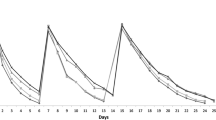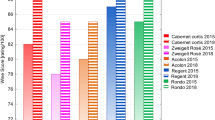Abstract
Rioja is one of the most important Spanish wine regions, and commonly produces wines with good aging potential. The quality of Rioja aged wines is well appreciated by tasters and consumers in the international wine market. In this study, the influence of the aromatic composition and oxidation on their sensory profile of different high-quality long-aged wines produced in Rioja was evaluated. The aromatic compounds that can participate actively on the aromatic profile of this type of wines have been identified. In this way, 3-methyl-2,4-nonanedione and 2-phenylacetaldehyde were the most sensory active compounds. At lesser extent, 3-methylbutanal, (E)-2-nonenal, and (E)-2-octenal were also important volatile compounds in this type of wines. Surprisingly, sotolon was only detected as active compounds in the oldest wines with lower price. Contrary, methional mainly appeared as active compound in the youngest samples of wines with higher price. 2-methylpropanal was a non-active compound in wines correctly aged and stored. This work contributes to an improved understanding about the key odorants in Rioja high-quality old wines.





Similar content being viewed by others
References
Loscos N, Hernández-Orte P, Cacho J, Ferreira V (2010) Evolution of the aroma composition of wines supplemented with grape flavour precursors from different varietals during accelerated wine ageing. Food Chem 120(1):205–216. https://doi.org/10.1016/j.foodchem.2009.10.008
Pons A, Lavigne V, Darriet P, Dubourdieu D (2013) Role of 3-methyl-2,4-nonanedione in the flavor of aged red wines. J Agric Food Chem 61(30):7373–7380. https://doi.org/10.1021/jf400348h
Hernández-Orte P, Lapeña AC, Escudero A, Astrain J, Baron C, Pardo I, Polo L, Ferrer S, Cacho J, Ferreira V (2009) Effect of micro-oxygenation on the evolution of aromatic compounds in wines: malolactic fermentation and ageing in wood. LWT Food Sci Technol 42(1):391–401. https://doi.org/10.1016/j.lwt.2008.05.020
Vilanova M, Genisheva Z, Graña M, Oliveira J (2013) Determination of odorants in varietal wines from international grape cultivars (Vitis vinífera) grown in NW Spain. South Afr J Enol Viticult 34(2):212–222. https://doi.org/10.21548/34-2-1097
Cacho J (2009) Genesis e importancia sensorial de los componentes aromaticos delvino. In, Logroño.
Escudero A, Cacho J, Ferreira V (2000) Isolation and identification of odorants generated in wine during its oxidation: a gas chromatography-olfactometric study. Eur Food Res Technol 211(2):105–110. https://doi.org/10.1007/s002179900128
Ferreira AC, Hogg T, Guedes de Pinho P (2003) Identification of key odorants related to the typical aroma of oxidation-spoiled white wines. J Agric Food Chem 51(5):1377–1381. https://doi.org/10.1021/jf025847o
Mayr CM, Capone DL, Pardon KH, Black CA, Pomeroy D, Francis IL (2015) Quantitative analysis by GC-MS/MS of 18 aroma compounds related to oxidative off-flavor in wines. J Agric Food Chem 63(13):3394–3401. https://doi.org/10.1021/jf505803u
Balboa-Lagunero T, Arroyo T, Cabellos JM, Aznar M (2011) Sensory and olfactometric profiles of red wines after natural and forced oxidation processes. Am J Enol Vitic 62(4):527–535. https://doi.org/10.5344/ajev.2011.10080
Ferreira AC, Barbe J-C, Bertrand A (2003) 3-Hydroxy-4,5-dimethyl-2(5H)-furanone: a key odorant of the typical aroma of oxidative aged port wine. J Agric Food Chem 51(15):4356–4363. https://doi.org/10.1021/jf0342932
Dubourdieu D, Pons A, Lavigne V (2010) Identificación de nuevos marcadores de envejecimiento. Enólogos Andaluces.
Allamy L, Darriet P, Pons A (2018) Molecular interpretation of dried-fruit aromas in Merlot and Cabernet Sauvignon musts and young wines: impact of over-ripening. Food Chem 266:245–253. https://doi.org/10.1016/j.foodchem.2018.06.022
Escudero A, Campo E, Fariña L, Cacho J, Ferreira V (2007) Analytical characterization of the aroma of five premium red wines. Insights into the role of odor families and the concept of fruitiness of wines. J Agric Food Chem 55(11):4501–4510. https://doi.org/10.1021/jf0636418
Pons A, Lavigne V, Eric F, Darriet P, Dubourdieu D (2008) Identification of volatile compounds responsible for prune aroma in prematurely aged red wines. J Agric Food Chem 56(13):5285–5290. https://doi.org/10.1021/jf073513z
Han G, Webb MR, Waterhouse AL (2019) Acetaldehyde reactions during wine bottle storage. Food Chem 290:208–215. https://doi.org/10.1016/j.foodchem.2019.03.137
Ferreira AC, De Pinho PG, Rodrigues P, Hogg T (2002) Kinetics of oxidative degradation of white wines and how they are affected by selected technological parameters. J Agric Food Chem 50(21):5919–5924. https://doi.org/10.1021/jf0115847
Bueno M, Culleré L, Cacho J, Ferreira V (2010) Chemical and sensory characterization of oxidative behavior in different wines. Food Res Int 43(5):1423–1428. https://doi.org/10.1016/j.foodres.2010.04.003
Bueno M, Carrascón V, Ferreira V (2016) Release and formation of oxidation-related aldehydes during wine oxidation. J Agric Food Chem 64(3):608–617. https://doi.org/10.1021/acs.jafc.5b04634
Bueno M, Zapata J, Ferreira V (2014) Simultaneous determination of free and bonded forms of odor-active carbonyls in wine using a headspace solid phase microextraction strategy. J Chromatogr A 1369:33–42. https://doi.org/10.1016/j.chroma.2014.10.004
Ferreira V, Escudero A, Lopez R, Cacho J (1998) Analytical characterization of the flavor of oxygen-spoiled wines through the gas chromatography-ion-trap mass spectrometry of ultratrace odorants: optimization of conditions. J Chromatogr Sci 36(7):331–339. https://doi.org/10.1093/chromsci/36.7.331
Pons A, Lavigne V, Darriet P, Dubourdieu D (2011) Determination of 3-methyl-2,4-nonanedione in red wines using methanol chemical ionization ion trap mass spectrometry. J Chromatogr A 1218(39):7023–7030. https://doi.org/10.1016/j.chroma.2011.08.017
Ferreira V, Culleré L, López R, Cacho J (2004) Determination of important odor-active aldehydes of wine through gas chromatography-mass spectrometry of their O-(2,3,4,5,6-pentafluorobenzyl) oximes formed directly in the solid phase extraction cartridge used for selective isolation. J Chromatogr A 1028(2):339–345. https://doi.org/10.1016/j.chroma.2003.11.104
López R, Ezpeleta E, Sánchez I, Cacho J, Ferreira V (2004) Analysis of the aroma intensities of volatile compounds released from mild acid hydrolysates of odourless precursors extracted from Tempranillo and Grenache grapes using gas chromatography-olfactometry. Food Chem 88(1):95–103. https://doi.org/10.1016/j.foodchem.2004.01.025
Collin S, Nizet S, Bouuaert T, Despatures PM (2012) Main odorants in Jura flor-sherry wines. Relative contributions of sotolon, abhexon, and theaspirane-derived compounds. J Agric Food Chem 60(1):380–387. https://doi.org/10.1021/jf203832c
Alamo-Sanza Md, Nevares I, Martínez-Gil A, Rubio-Bretón P, Garde-Cerdán T (2019) Impact of long bottle aging (10 years) on volatile composition of red wines micro-oxygenated with oak alternatives. LWT Food Sci Technol 101:395–403. https://doi.org/10.1016/j.lwt.2018.11.049
Compendium of international methods of wine and must analysis. (2016)
Torrens J, Riu-Aumatell M, López-Tamames E, Buxaderas S (2004) Volatile compounds of red and white wines by headspace-solid-phase microextraction using different fibers. J Chromatogr Sci 42:310–316. https://doi.org/10.1093/chromsci/42.6.310
Zapata J, Mateo-Vivaracho L, Cacho J, Ferreira V (2010) Comparison of extraction techniques and mass spectrometric ionization modes in the analysis of wine volatile carbonyls. Anal Chim Acta 660(1):197–205. https://doi.org/10.1016/j.aca.2009.09.041
Tessini C, Müller N, Mardones C, Meier D, Berg A, von Baer D (2012) Chromatographic approaches for determination of low-molecular mass aldehydes in bio-oil. J Chromatogr A 1219:154–160. https://doi.org/10.1016/j.chroma.2011.10.093
García-Puente E, Alcalde-Eon C, Santos-Buelga C, Rivas-Gonzalo JC, Escribano-Bailón MT (2006) Behaviour and characterisation of the colour during red wine making and maturation. Anal Chim Acta 563:215–222. https://doi.org/10.1016/j.aca.2005.11.044
Ferrer-Gallego R, Hernández-Hierro JM, Rivas-Gonzalo JC, Escribano-Bailón MT (2012) Influence of climatic conditions on the phenolic composition of Vitis vinifera L. cv Graciano. Anal Chim Acta 732:73–77. https://doi.org/10.1016/j.aca.2011.12.072
Ferreira V, López R, Cacho JF (2000) Quantitative determination of the odorants of young red wines from different grape varieties. J Sci Food Agric 80(11):1659–1667. https://doi.org/10.1002/1097-0010(20000901)80:11%3c1659:aid-jsfa693%3e3.0.co;2-6
Francis IL, Newton JL (2005) Determining wine aroma from compositional data. Aust J Grape Wine Res 11(2):114–126. https://doi.org/10.1111/j.1755-0238.2005.tb00283.x
Gómez-Míguez MJ, Cacho JF, Ferreira V, Vicario IM, Heredia FJ (2007) Volatile components of Zalema white wines. Food Chem 100(4):1464–1473. https://doi.org/10.1016/j.foodchem.2005.11.045
Peinado RA, Moreno J, Bueno JE, Moreno JA, Mauricio JC (2004) Comparative study of aromatic compounds in two young white wines subjected to pre-fermentative cryomaceration. Food Chem 84(4):585–590. https://doi.org/10.1016/S0308-8146(03)00282-6
Yong-Sheng T, Li H (2009) Active volatiles of cabernet sauvignon wine from Changli County. Health 1(3):176–182
Ancín-Azpilicueta C, González-Marco A, Jiḿenez-Moreno N (2009) Evolution of esters in aged Chardonnay wines obtained with different vinification methods. J Sci Food Agric 89(14):2446–2451. https://doi.org/10.1002/jsfa.3744
Câmara JS, Alves MA, Marques JC (2006) Changes in volatile composition of Madeira wines during their oxidative ageing. Anal Chim Acta 563(1):188–197. https://doi.org/10.1016/j.aca.2005.10.031
Pérez-Magariño S, Bueno-Herrera M, López de la Cuesta P, González-Lázaro M, Martínez-Lapuente L, Guadalupe Z, Ayestarán B (2018) Volatile composition, foam characteristics and sensory properties of Tempranillo red sparkling wines elaborated using different techniques to obtain the base wines. Eur Food Res Technol. https://doi.org/10.1007/s00217-018-3209-y
Lavigne V, Pons A, Darriet P, Dubourdieu D (2008) Changes in the sotolon content of dry white wines during barrel and bottle aging. J Agric Food Chem 56(8):2688–2693. https://doi.org/10.1021/jf072336z
Gaspar JM, Pereira V, Marqués J (2018) Odor detection threshold (ODT) and odor rejection threshold (ORT) determination of sotolon in Madeira wine: a preliminary study. AIMS Agriculture and Food 3(3):172–180
Pino JA, Queris O (2010) Analysis of volatile compounds of pineapple wine using solid-phase microextraction techniques. Food Chem 122(4):1241–1246. https://doi.org/10.1016/j.foodchem.2010.03.033
Guth H (1997) Quantitation and sensory studies of character impact odorants of different white wine varieties. J Agric Food Chem 45(8):3027–3032. https://doi.org/10.1021/jf970280a
Acknowledgements
The authors would like to acknowledge the Ministerio of Economía, Industria and Competitividad and the Centro for the Desarrollo Tecnológico Industrial (CDTI) for their financial support, Proyecto VINySOST Programa Estratégico de Consorcios de Investigación Empresarial Nacional 2014 (CIEN). Authors also acknowledge Bodegas RODA S.A. (Haro, La Rioja, Spain) for suppling wine samples and for its contribution.
Author information
Authors and Affiliations
Corresponding author
Ethics declarations
Conflict of interest
The authors declare no conflict of interest.
Compliance with ethics requirements
This article does not contain any studies with human or animal subjects.
Additional information
Publisher's Note
Springer Nature remains neutral with regard to jurisdictional claims in published maps and institutional affiliations.
Electronic supplementary material
Below is the link to the electronic supplementary material.
Rights and permissions
About this article
Cite this article
Mislata, A.M., Puxeu, M., Tomás, E. et al. Influence of the oxidation in the aromatic composition and sensory profile of Rioja red aged wines. Eur Food Res Technol 246, 1167–1181 (2020). https://doi.org/10.1007/s00217-020-03473-4
Received:
Revised:
Accepted:
Published:
Issue Date:
DOI: https://doi.org/10.1007/s00217-020-03473-4




